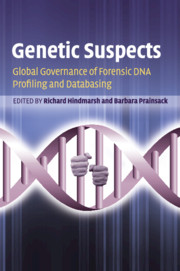Book contents
- Frontmatter
- Contents
- List of contributors
- About the contributors
- Foreword
- Acknowledgements
- 1 Introducing Genetic Suspects
- Section 1 Key areas in DNA profiling and databasing
- Section 2 National contexts of forensic DNA technologies and key issues
- 7 DNA databases and the forensic imaginary
- 8 Partners in crime: the use of forensic DNA technologies in Austria
- 9 Inquisitorial forensic DNA profiling in the Netherlands and the expansion of the forensic genetic body
- 10 DNA the Nor-way: black-boxing the evidence and monopolising the key
- 11 Portuguese forensic DNA database: political enthusiasm, public trust and probable issues in future practice
- 12 On trial! Governing forensic DNA technologies in the USA
- 13 Biosurveillance and biocivic concerns, from ‘truth’ to ‘trust’: the Australian forensic DNA terrain
- 14 Finding the balance: forensic DNA profiling in New Zealand
- 15 Forensic DNA profiling and databasing: the Philippine experience
- Section 3 Conclusions
- Index
- References
14 - Finding the balance: forensic DNA profiling in New Zealand
from Section 2 - National contexts of forensic DNA technologies and key issues
Published online by Cambridge University Press: 05 October 2012
- Frontmatter
- Contents
- List of contributors
- About the contributors
- Foreword
- Acknowledgements
- 1 Introducing Genetic Suspects
- Section 1 Key areas in DNA profiling and databasing
- Section 2 National contexts of forensic DNA technologies and key issues
- 7 DNA databases and the forensic imaginary
- 8 Partners in crime: the use of forensic DNA technologies in Austria
- 9 Inquisitorial forensic DNA profiling in the Netherlands and the expansion of the forensic genetic body
- 10 DNA the Nor-way: black-boxing the evidence and monopolising the key
- 11 Portuguese forensic DNA database: political enthusiasm, public trust and probable issues in future practice
- 12 On trial! Governing forensic DNA technologies in the USA
- 13 Biosurveillance and biocivic concerns, from ‘truth’ to ‘trust’: the Australian forensic DNA terrain
- 14 Finding the balance: forensic DNA profiling in New Zealand
- 15 Forensic DNA profiling and databasing: the Philippine experience
- Section 3 Conclusions
- Index
- References
Summary
INTRODUCTION
Since the mid 1980s, DNA identification techniques have become a routine element of criminal investigations and court proceedings. New Zealand was an early adopter of forensic DNA technologies, developing a close relationship with the Forensic Science Service in the UK where the techniques were pioneered. Forensic DNA laboratories were established in New Zealand in 1988, and DNA profiling immediately proved to be an invaluable tool for solving crime. As a geographically small and isolated nation with a modest population size of less than four million, and with a single legal jurisdiction, New Zealand perhaps was an ideal environment in which to successfully introduce DNA profiling technologies.
The use of DNA testing was recognised as an important and valuable investigative tool and by the early 1990s it was frequently incorporated into serious crime investigations. Yet, there was rising discomfort regarding police powers to obtain samples from suspects in the absence of any legislation. That discomfort was reflected in key judicial decisions, which considered whether or not police actions in obtaining biological samples infringed on the donor's rights. Subsequently, in 1995, New Zealand became the second nation after the UK to legislate for the establishment of a national DNA databank (Harbison et al. 1999).
- Type
- Chapter
- Information
- Genetic SuspectsGlobal Governance of Forensic DNA Profiling and Databasing, pp. 288 - 308Publisher: Cambridge University PressPrint publication year: 2010
References
- 1
- Cited by



